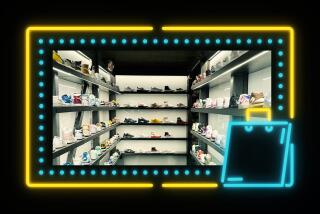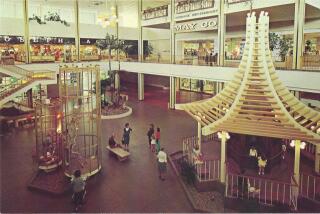The Broadway: Bright History, Uncertain Future
- Share via
On Feb. 24, 1896, a British-born merchant named Arthur Letts opened the Broadway Department Store in a 40-by-100-foot building at 4th Street and Broadway, then the outskirts of Los Angeles. The business made Letts so rich that he bought up a huge chunk of ranchland for $2 million and called it Holmby Hills. His son later built what is today the Playboy Mansion.
During the boom years after World War II, a visionary young Broadway president, Edward W. Carter, followed the freeway map and devised the idea of a suburban department store chain.
By the late 1970s, the company had burgeoned into the nation’s sixth-largest retailing operation--the only major retailer based in Los Angeles--with a far-flung network of department and specialty stores in the United States and Canada that included prestigious Neiman Marcus.
It was a company that came of age with Los Angeles and seemed to share its boundless possibilities.
But on Monday, 95 years after its founding and vastly shrunken from its heyday, the company that became Carter Hawley Hale Stores Inc. filed for bankruptcy court protection from creditors--a victim of heavy debt, hefty competition, misguided expansion and an ill-fated trimming back.
“You just get sort of queasy,” Jack A. Kyser, chief economist at the Los Angeles Area Chamber of Commerce, said of Broadway’s troubles. “It’s like seeing a friend who’s sick.”
The Broadway and its companion chains--Weinstocks in Sacramento, Emporium in San Francisco and Broadway-Southwest in Phoenix--might yet emerge healthy. Under Chapter 11, a company continues to operate while it develops a plan to reorganize and pay its debts. Bloomingdale’s in New York is one of many debt-burdened, big-name retailers operating that way.
However, Monday’s action represents a painful personal setback for Edward Carter’s protege and successor, Philip M. Hawley, a stylish fixture in the Los Angeles business community who has sat on the boards of BankAmerica Corp., Atlantic Richfield, Walt Disney Co. and other major California companies.
Hawley was the architect in late 1986 of a plan to spin off glamorous Neiman Marcus and Bergdorf Goodman and spunky Contempo Casuals to General Cinema Corp., a Boston beverage bottle and theater owner that had helped Carter Hawley avert a takeover by The Limited Inc. in 1984.
Hawley’s idea was that he could rejuvenate a sagging bottom line by injecting more vitality into the department stores and shielding the company from further takeover sieges. Unfortunately, the corporate overhaul plan, which thwarted a second takeover attempt by The Limited, entailed taking on enormous debt.
If things had gone according to plan, the debt might have been manageable. But Carter Hawley’s markets are among the nation’s most competitive, with customers spoiled by choices ranging from tony Rodeo Drive shops to service-minded Nordstrom to trendy boutiques and bargain-conscious off-price chains, warehouse clubs, outlet stores and discounters.
Now, Carter Hawley has followed other overly leveraged competitors, such as Campeau Corp.’s Federated department stores and Allied stores, into the protective custody of bankruptcy court.
As it is, the flagship Broadway chain long ago began losing much of the luster that made it for years the first choice of many households. Many stores are in need of remodeling, and the merchandising lacks pizazz.
“I remember going to a Broadway near Hollywood and Vine as a child,” said Laurie Muhlbauer, 34, a Los Angeles native who works at a Century City public relations firm. “That’s where we got our dresses for high school dances and Easter Sunday.
“Unfortunately, the last couple of years it seems they haven’t carried as much quality fashion merchandise. If you want fashion flair, you go to boutiques.”
Nonetheless, Muhlbauer said she still shops at the Broadway for such basics as stockings, cosmetics and linens and would miss it if it were gone.
“It is an institution,” she said. “If we lose a business like the Broadway, it’s a very bad sign.”
Arthur Letts’ single store had become three by 1945, with sales of $33 million, when Carter--a promising May Co. merchandise manager, UCLA graduate and Harvard MBA--was brought in to upgrade the company. A year later, at 34, he was named president.
Carter developed a knack for site selection, leading the department store charge into suburban shopping centers. He also began acquiring other companies, usually family held enterprises eager to grow but short of funds.
One such was Hale Bros. Stores Inc., a chain of six midline department stores in Northern California, including Weinstocks, that had become big vendors of appliances in the early days of radio and refrigerators. The company became Broadway-Hale Stores Inc. in 1950.
Hale Bros. was headed by Prentis Cobb Hale and his family, which was prominent in San Francisco society. In 1981, at a wedding anniversary party in Los Angeles, Hale and his wife were serenaded by the likes of Sammy Cahn, Carol Channing and Edie Adams and toasted by producer Fred de Cordova.
In 1969, Carter added Neiman Marcus of Dallas, renowned for its Christmas catalogue, and Waldenbooks, a bookstore chain. A poor fourth among the city’s four major department store operations, the Broadway expanded into San Diego and Phoenix and merged with Emporium Capwell Co. of San Francisco. Purchases of Bergdorf Goodman, Holt Renfrew of Canada and a 20% stake in House of Fraser, owner of Harrods in London, followed.
Sales by 1972 had reached $1 billion and Carter was named chairman, yielding the presidency to longtime protege Philip Metschan Hawley, the son of a Portland, Ore., paper mill owner. Hawley had been hired as an assistant sportswear buyer for the Broadway 14 years earlier and had worked his way through the merchandising ranks, eventually overseeing the Broadway division. Previously, he served in the Navy in World War II and operated a group of ice cream stores in Portland called, coincidentally, the Broadway Ice Cream Bowl.
The personable Hawley, a Phi Beta Kappa graduate at 19 from UC Berkeley, quickly and literally made a name for himself at the company. In 1974, the corporation was renamed Carter Hawley Hale Stores Inc.
Three years later, Hawley succeeded Carter as chief executive and embarked on a strategic shift. Carter, 79, and Hale, 80, remain on the company’s 12-member board.
Hawley negotiated the sale of the company’s 20% interest in Harrods to get cash for acquisitions. A fierce, unsuccessful bid for Marshall Field & Co. in Chicago was followed by the 1978 purchases of John Wanamaker in Philadelphia and Thalhimers in the Southeast. Contempo Casuals, a Los Angeles sportswear chain, was added the next year.
The 1970s buying binge transformed the company into one of the nation’s largest retailers, with 11 divisions and more than $2 billion in sales. It also created a complex empire with some money-losing elements.
In the 1980s, problems escalated. Projects to turn around sagging businesses took longer than expected. Once a Wall Street darling, Carter Hawley developed a reputation for promising more than it delivered.
It lost market share by reacting slowly to increasingly competition from R. H. Macy & Co., Nordstrom and others. As one retailing analyst told the Wall Street Journal in 1984: “God gave them California and they blew it.”
For all its middle-of-the-road emphasis, the Broadway did not always lack merchandising zest. In 1979, Broadway executives were the first to visit China after the normalization of relations. The result was a two-week promotion in 1980 featuring Chinese cashmere sweaters, silk blouses, furniture, rugs, antique jade and porcelain.
In 1984, the tables were turned on Hawley, the acquirer, when The Limited launched its first bid. General Cinema stepped in as white knight. Observers said later that General Cinema forced Hawley’s hand and got him to part with the specialty stores.
Hawley, 65, is described by friends as an eternal optimist. The father of eight children, he and his wife, Mary Catherine, live next door to Dodgers baseball club owner Peter O’Malley in an old-money part of fashionable Hancock Park. His hobby is collecting first-edition Sherlock Holmes books.
Comfortable in Los Angeles club society, Hawley has weathered many a harsh assessment of his management in recent years. Some view him as elitist and egotistical and contend that he “entrenched” himself at the expense of shareholders and employees. To many, it seemed that he became so enamored of financial intricacies that he lost sight of his company’s raison d’etre and the company lost its way.
“He’s not in any way anything but a fine, respected person,” said Walter F. Loeb, a retailing consultant in New York and former research analyst with Morgan Stanley, Carter Hawley’s investment banker. “But he surrounded himself with ‘yes’ men.”
Now, observers say, Hawley has largely turned over the running of business to H. Michael Hecht, a highly regarded merchant and manager recently named president of the corporation after years as chairman of the Broadway division.
Nonetheless, Hawley, three years from a scheduled retirement, faces his biggest challenge ever--ensuring the survival of the Broadway.
“There has always been a Broadway,” said the Chamber of Commerce’s Kyser. “And you hope there always will be.”
Times research librarian Peter Johnson contributed to this story.
CARTER HAWLEY CHRONOLOGY
* 1896: Arthur Letts opens a 4,000-square-foot store at 4th and Broadway called the Broadway Department Store.
* 1946: Former May Co. merchandising manager Edward W. Carter is appointed president of the three-store Broadway chain.
* 1950: The company becomes Broadway-Hale Store with the purchase of Hale Bros. Stores in Northern California.
* 1969: Edward Carter engineers purchase of Neiman Marcus of Dallas, and Waldenbooks; merges with Emporium Capwell Co. of San Francisco.
* 1972: Philip M. Hawley named president
* 1972: Company purchases Bergdorf Goodman.
* 1974: Corporation named Carter Hawley Hale Stores.
* 1977: Hawley unsuccessfully bids for Marshall Field & Co. in Chicago.
* 1978: Company buys Wanamaker in Philadelphia and Thalhimers in Richmond, Va.
* 1984: Specialty retailer The Limited Inc. launches unsuccessful $1.1-billion bid to buy Carter Hawley.
* 1986: The Limited Inc. and shopping mall developer Edward J. DeBartolo Sr. make a second $1.93-billion takeover bid for Carter Hawley; Carter Hawley rejects takeover offer and announces plan to spin off its specialty retailing division, which included Neiman Marcus and Contempo Casuals, into a separate company.
* June, 1987: Carter Hawley says it will cost more than $1 billion to finance the costs of major restructuring, including the Neiman Marcus spinoff.
* July, 1987: Carter Hawley unveils an employee ownership plan that would leave workers owning more than 50% of the company as well as serving to discourage hostile takeovers.
* August, 1987: Shareholders approve Carter Hawley plans to spin off specialty retail operations. Stock reaches a record high--$77 a share.
* September, 1989: Carter Hawley’s profit for the fiscal year falls to $13.5 million.
* October, 1989: Bay Area quake causes $7 million to $10 million in damage and lost sales at the Emporium.
* October, 1990: Carter Hawley reports a loss of $26 million for the fiscal year and says it will reduce its work force by 1,000. Stock sinks to $3 a share.
* December, 1990: Carter Hawley receives $317 million after selling its Thalhimers division to May Department Stores.
* January, 1991: Carter Hawley announces plan to sell its credit card division.
* Feb. 6, 1991: Carter Hawley stock is the biggest loser on the New York Stock Exchange; company acknowledges that the credit card deal fell through and says it will not go through with a planned bank line of credit.
* Feb. 11, 1991: Carter Hawley announces Chapter 11 filing.
More to Read
Inside the business of entertainment
The Wide Shot brings you news, analysis and insights on everything from streaming wars to production — and what it all means for the future.
You may occasionally receive promotional content from the Los Angeles Times.











